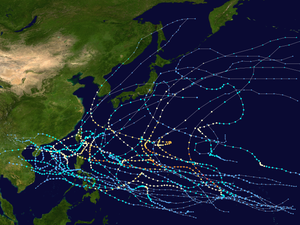
Back 1986年の台風 Japanese 1986년 태풍 Korean Mùa bão Tây Bắc Thái Bình Dương 1986 Vietnamese 1986年太平洋颱風季 Chinese
| 1986 Pacific typhoon season | |
|---|---|
 Season summary map | |
| Seasonal boundaries | |
| First system formed | January 29, 1986 |
| Last system dissipated | January 3, 1987 |
| Strongest storm | |
| Name | Peggy |
| • Maximum winds | 205 km/h (125 mph) (10-minute sustained) |
| • Lowest pressure | 900 hPa (mbar) |
| Seasonal statistics | |
| Total depressions | 48 |
| Total storms | 29 |
| Typhoons | 19 |
| Super typhoons | 3 (unofficial) |
| Total fatalities | 905 total |
| Total damage | ≥ $508.5 million (1986 USD) |
| Related articles | |
The 1986 Pacific typhoon season was an above average season, featuring 29 named storms, 19 typhoons, and 3 super typhoons. It has no official bounds; it ran year-round in 1986, but most tropical cyclones tend to form in the northwestern Pacific Ocean between May and December. These dates conventionally delimit the period of each year when most tropical cyclones form in the northwestern Pacific Ocean. Tropical Storms formed in the entire west pacific basin were assigned a name by the Joint Typhoon Warning Center. Tropical depressions that enter or form in the Philippine area of responsibility are assigned a name by the Philippine Atmospheric, Geophysical and Astronomical Services Administration or PAGASA. This can often result in the same storm having two names.
A total of 32 tropical depressions formed in 1986 in the Western Pacific over an eleven-month time span. Of the 32, 30 became tropical storms, 19 storms reached typhoon intensity, and 3 reached super typhoon strength. The Joint Typhoon Warning Center considered Vera as two tropical cyclones, when all the warning centers treated Vera as one in real time, while another, Georgette, originated in the Eastern Pacific. Six of the tropical cyclones formed in August, which was the busiest month of the season. Eight tropical cyclones moved through the Philippines this season. Most of the deaths attributed to typhoons in 1986 were caused by Peggy and Wayne.